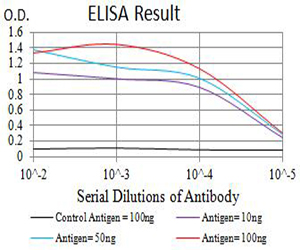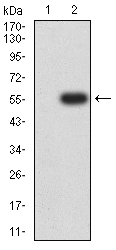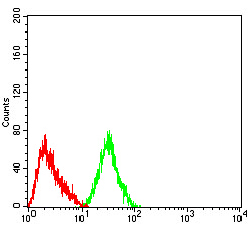CHRNA4
Purified Mouse Monoclonal Antibody
- SPECIFICATION
- CITATIONS
- PROTOCOLS
- BACKGROUND

Application
| WB, IHC, ICC, E |
|---|---|
| Primary Accession | P43681 |
| Reactivity | Human |
| Host | Mouse |
| Clonality | Monoclonal |
| Clone Names | 7B4H1 |
| Isotype | Mouse IgG1 |
| Calculated MW | 70kDa |
| Immunogen | Purified recombinant fragment of human CHRNA4 (AA: extra 29-242) expressed in E. Coli. |
| Formulation | Purified antibody in PBS with 0.05% sodium azide |
| Gene ID | 1137 |
|---|---|
| Other Names | EBN; BFNC; EBN1; NACHR; NACRA4; NACHRA4 |
| Dilution | WB~~ 1/500 - 1/2000 IHC~~1:100~500 ICC~~N/A E~~ 1/10000 |
| Storage | Maintain refrigerated at 2-8°C for up to 6 months. For long term storage store at -20°C in small aliquots to prevent freeze-thaw cycles. |
| Precautions | CHRNA4 is for research use only and not for use in diagnostic or therapeutic procedures. |
| Name | CHRNA4 (HGNC:1958) |
|---|---|
| Synonyms | NACRA4 |
| Function | Component of neuronal acetylcholine receptors (nAChRs) that function as pentameric, ligand-gated cation channels with high calcium permeability among other activities. nAChRs are excitatory neurotrasnmitter receptors formed by a collection of nAChR subunits known to mediate synaptic transmission in the nervous system and the neuromuscular junction. Each nAchR subunit confers differential attributes to channel properties, including activation, deactivation and desensitization kinetics, pH sensitivity, cation permeability, and binding to allosteric modulators (PubMed:22361591, PubMed:27698419, PubMed:29720657, PubMed:38454578). CHRNA4 forms heteropentameric neuronal acetylcholine receptors with CHRNB2 and CHRNB4, as well as CHRNA5 and CHRNB3 as accesory subunits. Is the most abundant nAChR subtype expressed in the central nervous system (PubMed:16835356, PubMed:22361591, PubMed:27698419, PubMed:29720657, PubMed:38454578). Found in two major stoichiometric forms,(CHRNA4)3:(CHRNB2)2 and (CHRNA4)2:(CHRNB2)3, the two stoichiometric forms differ in their unitary conductance, calcium permeability, ACh sensitivity and potentiation by divalent cation (PubMed:27698419, PubMed:29720657, PubMed:38454578). Involved in the modulation of calcium-dependent signaling pathways, influences the release of neurotransmitters, including dopamine, glutamate and GABA (By similarity). |
| Cellular Location | Synaptic cell membrane {ECO:0000250|UniProtKB:O70174}; Multi-pass membrane protein. Cell membrane {ECO:0000250|UniProtKB:O70174}; Multi-pass membrane protein |

Thousands of laboratories across the world have published research that depended on the performance of antibodies from Abcepta to advance their research. Check out links to articles that cite our products in major peer-reviewed journals, organized by research category.
info@abcepta.com, and receive a free "I Love Antibodies" mug.
Provided below are standard protocols that you may find useful for product applications.
References
1.Epilepsy Res. 2014 Dec;108(10):1927-31.2.J Pharmacol Exp Ther. 2014 Mar;348(3):410-20.
If you have used an Abcepta product and would like to share how it has performed, please click on the "Submit Review" button and provide the requested information. Our staff will examine and post your review and contact you if needed.
If you have any additional inquiries please email technical services at tech@abcepta.com.













 Foundational characteristics of cancer include proliferation, angiogenesis, migration, evasion of apoptosis, and cellular immortality. Find key markers for these cellular processes and antibodies to detect them.
Foundational characteristics of cancer include proliferation, angiogenesis, migration, evasion of apoptosis, and cellular immortality. Find key markers for these cellular processes and antibodies to detect them. The SUMOplot™ Analysis Program predicts and scores sumoylation sites in your protein. SUMOylation is a post-translational modification involved in various cellular processes, such as nuclear-cytosolic transport, transcriptional regulation, apoptosis, protein stability, response to stress, and progression through the cell cycle.
The SUMOplot™ Analysis Program predicts and scores sumoylation sites in your protein. SUMOylation is a post-translational modification involved in various cellular processes, such as nuclear-cytosolic transport, transcriptional regulation, apoptosis, protein stability, response to stress, and progression through the cell cycle. The Autophagy Receptor Motif Plotter predicts and scores autophagy receptor binding sites in your protein. Identifying proteins connected to this pathway is critical to understanding the role of autophagy in physiological as well as pathological processes such as development, differentiation, neurodegenerative diseases, stress, infection, and cancer.
The Autophagy Receptor Motif Plotter predicts and scores autophagy receptor binding sites in your protein. Identifying proteins connected to this pathway is critical to understanding the role of autophagy in physiological as well as pathological processes such as development, differentiation, neurodegenerative diseases, stress, infection, and cancer.





